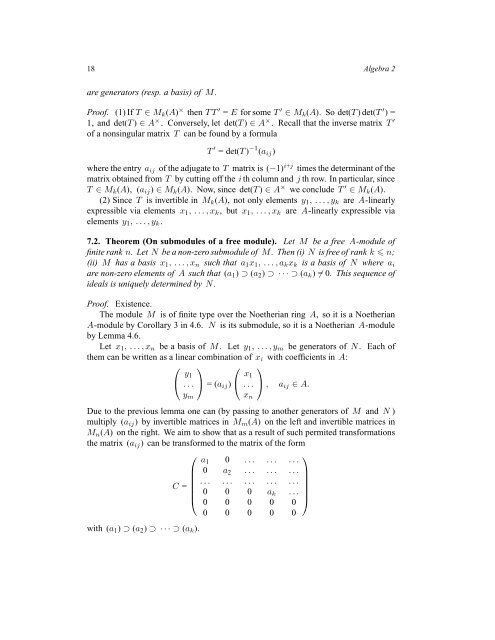Algebra (Unknown 27). - Index of
Algebra (Unknown 27). - Index of
Algebra (Unknown 27). - Index of
Create successful ePaper yourself
Turn your PDF publications into a flip-book with our unique Google optimized e-Paper software.
18 <strong>Algebra</strong> 2<br />
are generators (resp. a basis) <strong>of</strong> M .<br />
Pro<strong>of</strong>. (1) If T ∈ M k (A) × then T T ′ = E for some T ′ ∈ M k (A). So det(T ) det(T ′ ) =<br />
1, and det(T ) ∈ A × . Conversely, let det(T ) ∈ A × . Recall that the inverse matrix T ′<br />
<strong>of</strong> a nonsingular matrix T can be found by a formula<br />
T ′ = det(T ) −1 (a ij )<br />
where the entry a ij <strong>of</strong> the adjugate to T matrix is (−1) i+j times the determinant <strong>of</strong> the<br />
matrix obtained from T by cutting <strong>of</strong>f the i th column and j th row. In particular, since<br />
T ∈ M k (A), (a ij ) ∈ M k (A). Now, since det(T ) ∈ A × we conclude T ′ ∈ M k (A).<br />
(2) Since T is invertible in M k (A), not only elements y 1 , . . . , y k are A-linearly<br />
expressible via elements x 1 , . . . , x k , but x 1 , . . . , x k are A-linearly expressible via<br />
elements y 1 , . . . , y k .<br />
7.2. Theorem (On submodules <strong>of</strong> a free module). Let M be a free A-module <strong>of</strong><br />
finite rank n. Let N be a non-zero submodule <strong>of</strong> M . Then (i) N is free <strong>of</strong> rank k n;<br />
(ii) M has a basis x 1 , . . . , x n such that a 1 x 1 , . . . , a k x k is a basis <strong>of</strong> N where a i<br />
are non-zero elements <strong>of</strong> A such that (a 1 ) ⊃ (a 2 ) ⊃ · · · ⊃ (a k ) ≠ 0. This sequence <strong>of</strong><br />
ideals is uniquely determined by N .<br />
Pro<strong>of</strong>. Existence.<br />
The module M is <strong>of</strong> finite type over the Noetherian ring A, so it is a Noetherian<br />
A-module by Corollary 3 in 4.6. N is its submodule, so it is a Noetherian A-module<br />
by Lemma 4.6.<br />
Let x 1 , . . . , x n be a basis <strong>of</strong> M . Let y 1 , . . . , y m be generators <strong>of</strong> N . Each <strong>of</strong><br />
them can be written as a linear combination <strong>of</strong> x i with coefficients in A:<br />
⎛<br />
⎝ y ⎞<br />
1<br />
. . .<br />
y m<br />
⎠ = (a ij )<br />
⎛<br />
⎝ x ⎞<br />
1<br />
. . .<br />
x n<br />
⎠ , a ij ∈ A.<br />
Due to the previous lemma one can (by passing to another generators <strong>of</strong> M and N )<br />
multiply (a ij ) by invertible matrices in M m (A) on the left and invertible matrices in<br />
M n (A) on the right. We aim to show that as a result <strong>of</strong> such permited transformations<br />
the matrix (a ij ) can be transformed to the matrix <strong>of</strong> the form<br />
⎛<br />
⎞<br />
a 1 0 . . . . . . . . .<br />
0 a 2 . . . . . . . . .<br />
. . . . . . . . . . . . . . .<br />
C =<br />
⎜ 0 0 0 a k . . . ⎟<br />
⎝<br />
⎠<br />
0 0 0 0 0<br />
0 0 0 0 0<br />
with (a 1 ) ⊃ (a 2 ) ⊃ · · · ⊃ (a k ).

















